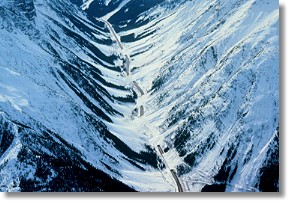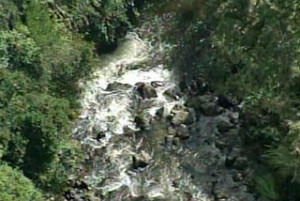Since 1978 (a little more than a generation ago), there have been three outdoor event tragedies involving school-age youth, which were cause for reflection in the outdoor recreation industry – one was a 1978 canoeing incident (13 fatalities), one was a 2003 snow skiing incident (7 fatalities), and one was a 2008 river gorge exploring incident (7 fatalities).
Despite the passage of time, the following lessons must not be forgotten!
(1) The Canadian school canoeing incident:

In June, 1978, 12 Canadian boarding school students and one adult (out of a group of 27 students of ages 11 to 14, and 4 adults) either drowned, or died of hypothermia, on the first day of an annual three-week boarding school-sponsored canoe trip in the Ontario wilderness.
On the afternoon of the first day, two of their four large 22 foot canoes (such as shown in the photo in actual use by the school in question) capsized while crossing a lake in the face of large swells due to windy conditions. The remaining two canoes capsized during attempted rescue attempts after having dropped their crews on shore. The water temperature was estimated to have been in the mid-40s.
At the end of the first day, there were only 18 survivors out of 31 participants, despite the fact that all participants wore PFDs. The survivors who managed to reach shore 100 to 300 yards away, as well as those who perished and remained floating in the cold water, were discovered only by happenstance by an overflying helicopter pilot the following day.
Tragically, this story is a perfect example of “likelihood of risk meeting severity of harm” for a youth-based group, with the group having to confront a multitude of risk factors (many foreseeable), including:
- crossing an unfamiliar lake prone to windy conditions,
- exceptionally cold lake water,
- young inexperienced participants,
- no prior paddling practice,
- the use of canoes ill-designed for heavy loading,
- poor supervision,
- the lack of advanced route planning,
- no swim ability testing,
- no capsized canoe practice,
- no canoe rescue practice,
- fatigued participants at departure due to overnight driving to the departure point,
- lack of breakfast prior to departure,
- no chain of command, and
- lack of emergency procedures.
These risk factors all came to bear at the same time to exact a heavy toll on trusting youth (and their families) for whom the four adult trek participants (one of whom also died) were serving as guardians.
The post-tragedy coroner’s report found such lack of training, emergency procedures, swimming skills, canoeing skills, communication ability, and experience level that it was concluded that “for boys from 12 to 14 years of age, this entire expedition constituted an “exaggerated and pointless challenge”.
As a result of the incident, the school (since closed) made a number of changes in its outdoor program, and the use of large canoes for recreational canoeing became disfavored in the outdoor recreation industry, particularly for canoe treks where the canoes became heavily loaded.
(Postscript – In June, 2016, fourteen Russian school-age children drowned when their boats overturned on a large lake whose water temperature was in the range of 45-50 degrees. History repeats.)
(2) The Canadian school ski touring incident:
 On February 1, 2003, 7 of 14 fifteen year old students from the school Strathcona Tweedsmuir lost their lives in an avalanche in British Columbia while ski touring the backcountry. The school had conducted such ski touring trips for its students for many years without incident, using generally-accepted risk management procedures. The incident occurred on Parks Canada land, which, at the time had a “use at your own risk” policy.
On February 1, 2003, 7 of 14 fifteen year old students from the school Strathcona Tweedsmuir lost their lives in an avalanche in British Columbia while ski touring the backcountry. The school had conducted such ski touring trips for its students for many years without incident, using generally-accepted risk management procedures. The incident occurred on Parks Canada land, which, at the time had a “use at your own risk” policy.
As a result of a post-incident review, Parks Canada instituted a new policy which prohibits use by custodial groups (school groups, Scouts, among others) of Parks Canada backcountry when the risk is potentially catastrophic (in effect, a regulatory standard of care for custodial groups).
Parks Canada’s new policy also required the use of a professional mountain guide with custodial groups under challenging conditions, limited the group size to not exceed 10 under those conditions, and specified limits on traversing avalanche terrain.
The school subsequently became more diligent when it came to obtaining informed consent from students’ parents, attempting to ensure that parents had a clear understanding regarding the scope of outdoor activities in which their sons or daughters would participate, as upon investigation, it became clear that most parents had little appreciation for the potential risk of the activity, or even what the ski touring event entailed.
There was also a world-wide attempt, based on Parks Canada efforts, to use a more accurate system to identify avalanche risk in the backcountry.
(3) The New Zealand river gorge incident:
 A 2008 New Zealand youth outdoor recreation tragedy demonstrates how an outdoor activity can have a catastrophic end result if one or more risk factors are ignored, or are dealt with inadequately.
A 2008 New Zealand youth outdoor recreation tragedy demonstrates how an outdoor activity can have a catastrophic end result if one or more risk factors are ignored, or are dealt with inadequately.
Six students and one teacher out of a group of twelve perished when they were trapped in the Mangatepopo Gorge in New Zealand (shown in the photo) when the river traversing the gorge rose due to heavy rains. Upon attempting to seek safety downstream by jumping at spaced intervals into the swollen river at the instruction of their accompanying guide, with the intent of being rescued downstream by the guide, the seven participants lost their lives.
The resulting coroner’s report attributed the tragedy to the following factors:
- lack of awareness of the likely effect of rain on the gorge,
- a failure to take into account historical flood data,
- a failure to properly assess the gorge prior to entering,
- inadequate communication means with the staff base when in the gorge,
- a failure to implement a crisis plan,
- an inexperienced guide,
- a failure to properly assess the water skills of the participants, and
- underestimating the overall risks of the activity.
As a result of the tragedy, significant changes were made in the manner that the outdoor school conducted its program.
Summary thoughts for BSA volunteer leaders:
It is important to note that each of the above activities had been conducted repeatedly by each organization over a number of years, perhaps leading to a bit of complacency. But, in reality, was each event actually repeated, given the differences each year in the instructors, differences in the participants, differences in the environment, etc.? Or, was that just a misperception on the part of the administrators of the respective programs who had seen the same event occur year after year, when in reality each was a new event?
Perhaps, an organization’s failure to recognize that each activity is, in reality, being conducted for the first time, may cause certain risk factors to be ignored, or overlooked, such as the skill and maturity of each participant, and the effect of the environment on such participants, as opposed to assuming that the activity will have a safe outcome as in the past. A useful point for Scout units to consider.
It has also been said that the useful half-life of knowledge of safety procedures and related teachable moments in groups can be short indeed, something that is also particularly applicable to Scout units which continually either add or lose adult volunteers.
Units must guard against having the overall risk management skills of the unit becoming diminished due to such turnover, to guard against placing Scouts in positions such as the youth of the above incidents were tragically placed.
